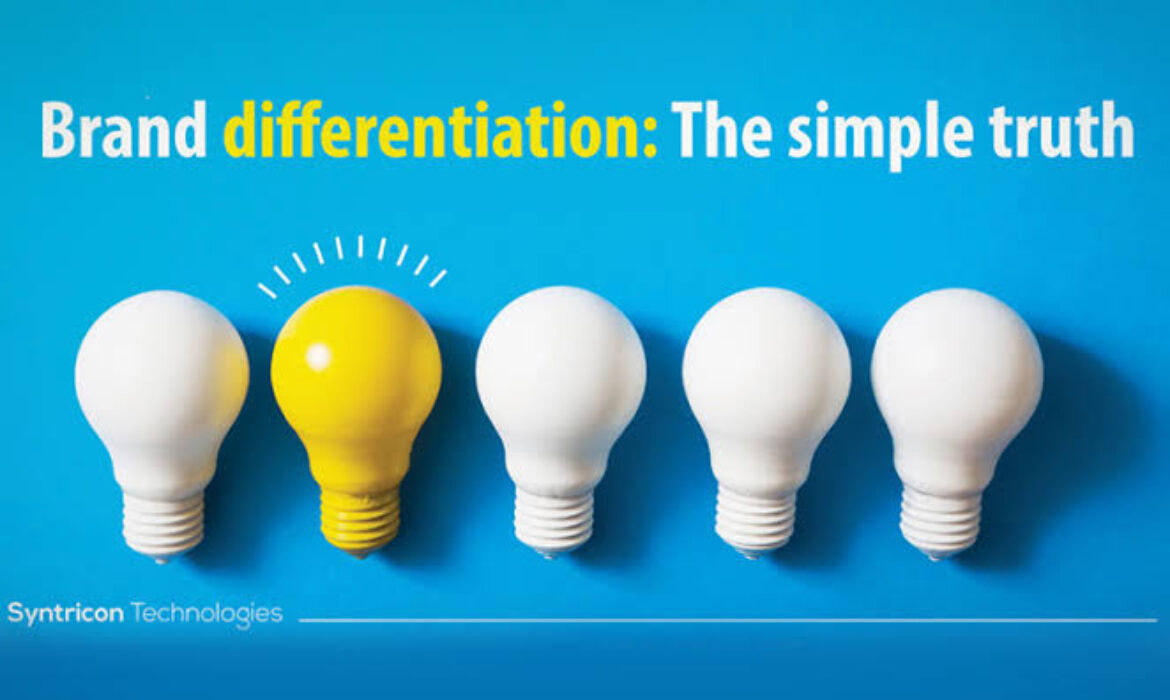081-4797-7173
“A brand is a voice and a product is a souvenir.” “It takes 20 years to build a reputation and five minutes to ruin it. If you think about that, you’ll do things differently.” “Brand identity fuels recognition amplifies differentiation and makes big ideas and meaning accessible”.
It’s no secret that today’s marketplace is packed with various businesses competing for their customer’s attention and loyalty.
In such a crowded environment, it can be challenging to stand out from the competition, but this is precisely where brand differentiation comes in.
Brand differentiation, therefore, focuses on what you can offer your customers. To differentiate yourself from similar retailers, in essence, you need to be able to provide something your competition does not.
Building a strong brand is the undisputed key to success in today’s business world, and robust differentiation is an absolute must to build a compelling brand.
In this article, we will be looking at
- What is brand differentiation?
- Why is brand differential important?
- Types of Brand Differentiation Strategy
- The benefit of brand differentiation
- Strategies for achieving brand differentiation
What is Brand Differentiation?
Brand differentiation is a procedure undertaken by companies who seek to ensure their brand stands out from their competitors.
By singling out unique qualities your products or services offer and promoting them in a way that best targets your consumers, you are likely to gain a competitive advantage over your rivals, which, in turn, should equate to increased market share.
Brand differentiation, therefore, focuses on what you can offer your customers. To differentiate yourself from similar retailers, in essence, you need to be able to provide something your competition does not.
Brand differentiation is the process of creating an identity that differentiates your business from other brands within customers’ minds.
Brand differentiation is an essential aspect of a brand marketing strategy. It enables companies to reveal their profitable qualities that help develop a unique selling proposition.
This way, they understand their competitive advantage and stand out among competitors.
Why is Brand differentiation important?
In today’s crowded marketplace, businesses must stand out to attract customers. This is where having a strong brand can make all the difference.
By creating a compelling brand that offers unique features, higher quality products or services, and outstanding customer service, businesses can differentiate themselves from other brands and create a loyal customer base.
Customers don’t value brands that sell the same items and don’t provide them with new solutions. It makes them believe that these companies are easily interchangeable.
This can cause a price war among brands because the only thing left to compete for is the price. As a result, undercutting your competitors’ prices leads to lower net profit.
With the competition constantly growing in today’s digital market, it is getting more challenging to stand out among the noise.
This is why companies such as Apple and Nike have efficiently capitalized on high-quality products and exceptional customer service and have successfully differentiated themselves from the rest of the majority.
Through innovative differentiation strategies and focusing on exceptional customer experiences, businesses can build a compelling brand that resonates with customers and drives growth and profitability.
In short, a strong brand is essential for businesses looking to establish themselves in the market and achieve long-term success.
In addition, Companies need their brands to stand out to avoid prepdatory pricing. This strategy provides them with both short-term and long-term goals.
The main one is to find your competitive advantage a unique offer that your business opponents don’t have. It will help boost your market share in the long term.
As a result, you’ll increase your targeted audience, sales volume, and revenue.
Types of Brand Differentiation Strategies
There are different types of brand differentiation strategies but a few are listed below
Product Differentiation Strategy
Product differentiation is a practical strategy in the business world. It gives companies a competitive advantage and allows them to stand out in the marketplace.
Customers looking for something unique or more advanced are often drawn to differentiating features and products that offer more excellent value than competitors.
A product differentiation strategy focuses on repeating features buyers can significantly benefit from.
It includes producing higher quality products and allowing product customization.
Some product differentiation examples are Samsung, annually providing a flagship model with high-end features vis-a-vis a premium price tier, and Nike’s use of AI technology, allowing buyers to customize and try on their shoes via augmented reality on the go.
Product differentiation has become an essential method for survival and maintaining market supremacy.
Having unique offerings and staying up to date on current trends can put every organization on the right track in this everchanging commercial arena.
Service Differentiation
As competition increases in the market, businesses must differentiate their services to stand out from other providers and build loyal customer bases.
The leading e-commerce company Amazon successfully disrupted the digital landscape through a service differentiation strategy with its One Day Delivery and 1-Click Checkout.
In a nutshell, Amazon took online shopping convenience to the next level.
As you can deduce, incorporating service differentiation results in trust building which can stimulate customer loyalty.
When established, a brand can accurately and confidently expand its services without customers second-guessing if they are worth the price.
Channel Differentiation Strategy
To stand out from the competition, channel differentiation is vital. It involves creating storefronts or platforms exclusive to your brand and supplying something customers can’t find from any other provider.
Warby Parker, an eyewear maker, has become the face of this tactic, selling their glasses in their stores and online.
Brands are also getting creative by launching products and services exclusive to buyers on specific channels at a special price.
However, it is best to not spread yourself too thin. Instead, create a highly targeted channel distribution strategy to minimize risk and optimize results.
Broad Differentiation Strategy
A broad differentiation strategy is about appealing to a wide base with a brand that speaks to commonly held values and expectations.
Companies like Trader Joe’s and Whole Foods, for example, are all about organic food and a healthy lifestyle, both of which appeal to a wide range of consumers from different backgrounds.
The Benefits of Brand Differentiation Strategies
Differentiation strategies have several advantages that may help you develop a unique niche within your industry.
Differentiation strategies are a must for almost every business because of how many benefits a well-executed one can have.
Here are the possible benefits of creating a differentiation strategy.
Reduced price competition
A differentiation strategy allows a company to compete in the market with something other than lower prices.
For example, a candy company may differentiate its candy by improving the taste or using healthier ingredients.
Although its competitors have cheaper candy, they can’t provide the taste that consumers may want from that specific candy company.
When your product stands out on its merits, then you won’t have to compete on price. You can set a higher price and let your competitors try to come in under you.
Unique products
The benefit of a differentiation strategy is that it builds on the unique qualities of a product. Your company may create a list of characteristics its products contain that your competitors lack.
Those characteristics will differentiate your product, and you may communicate this through effective marketing and advertising.
Better profit margins
When products are differentiated and turned into higher-quality products, it offers more opportunities for larger profit margins.
For example, if your target market is willing to pay a higher price for top quality or better value, you may generate more revenue with fewer sales.
Once you’ve differentiated your business or product, you can start charging a premium for it. People will be willing to pay extra to get the best product, or the one that best suits their needs.
Consumer brand loyalty
Effective differentiation may create brand loyalty in customers if a business maintains the perceived quality of its products.
For example, if you have a brand that is marketed by a sports figure, it will likely increase brand loyalty because it enhances the value of your brand.
If your product or service stands out from the others, then your customers will keep coming back. This can be in terms of status, quality, price, or ease of use.
Whatever the reason, having repeat customers makes a big difference in a company’s bottom line.
No perceived substitutes
A strategy that successfully differentiates may present the idea that there is no other product available on the market to substitute it with.
A business may gain an advantage in the market even when there are similar products available because customers will not be willing to replace your product with another one.
Companies try to differentiate themselves by providing consumers with unique products that are frequently revolutionized.
If your product or service is truly unique, then there isn’t anything that can replace it. That means that consumers won’t be pulled away from a competitor on price or features, because there won’t be anything that fills the same niche.
Strategies for Achieving Brand Differentiation
Tell a Unique Brand Story
One of the clearest strategies used by brands great and small is developing a unique story. When defining your core values with a mission statement or brand proposition, you can include the personality behind your company.
Who are the founders? What journey did they take to get here? Where does the brand plan to go in the future? Consumers love an underdog story, so if your business had humble beginnings be sure to highlight those.
Some of today’s biggest brands started small, whether it’s Amazon’s Jeff Bezos in his garage or Sir Richard Branson pitting his Virgin start-up against industry leaders.
Use Emotional Branding
This relies on providing an emotional salience that is linked to a product or service. We’ve found that brands that develop an emotional connection with their customers are often better positioned than those that provide a superior value.
Emotional branding is an effective way to establish a differentiated connection between customers and a company. It requires engaging with audiences to create loyal patronage and build lasting relationships.
To create an emotional bond, brands should focus on storytelling, crafting an appropriate brand personality, and using visually arresting and emotive messaging in marketing materials.
Coca-Cola’s emotional branding campaigns, such as the “Share a Coke”, “Share a Feeling ” and “Hug Me” campaigns, have helped the company create a strong emotional connection with customers and differentiate itself from other soft drink brands.
Personalization
Personalization can be a powerful tool used in business to craft a one-of-a-kind customer experience. Companies can use personalization to tailor their product recommendations and marketing to individual customers, building customer loyalty and increasing lifetime value.
However, such tactics come with their difficulties. Personalization requires companies to optimally collect and analyze customer data and invest in supporting technology.
Netflix’s personalized recommendation algorithm has helped the company differentiate itself from other streaming services and provide customers with a more personalized and enjoyable experience.
Innovation
This can be expressed through the physical characteristics of the products or how a product or service is delivered.
In short, this differentiation solves an unmet need in a unique and novel fashion.
This method is a surefire way to stand out. You can either create a product that people have never seen before or optimize and improve an existing one.
For this purpose, you need to research to understand your customers’ needs, pain points, preferences, etc.
Brands that bring innovations to the market are the most successful, remarkable, and trusted.
James Dyson is an example of someone who developed an innovative product (a vacuum cleaner) thus positioning his company as a leader in innovation.
With this positioning, the company has gone on to continually innovate by bringing many other novel products to market.
Pricing
When handled properly, this can also be an effective approach to differentiation. On one end of the spectrum, a company can strive to be positioned as the ‘low price leader’ offering customers outstanding value.
On the other end, they could be positioned as a premium brand at a high price.
In some cases, an effective brand differentiation strategy can enable a brand to command a higher price premium than it otherwise could obtain.
On the lower end, Walmart stores are known for their low prices and good values which has allowed the company to reshape retail.
On the other end of the spectrum, Starbucks has convinced consumers that there is value in paying much more for coffee than they would have before the company disrupted the purchase of coffee.
Become a Niche
Niche products or services have built-in brand differentiation, and the marketing for them should reflect that niche.
A good example is GoPro, which makes body-mounted video cameras and markets them to sports people.
Becoming a niche to differentiate your brand more strongly is often a very effective strategy for more modestly sized businesses because you’re working with leaner resources.
Offering products or services in a very specific niche where you become the known subject matter expert can be a very effective differentiation strategy.
However it’s important to ensure there is sufficient market demand or opportunity to create demand so you can achieve your revenue targets.
Make it Convenient
Convenience can be a big brand differentiator. Something that makes life much easier for your customers often makes you more desirable than the competition in a category, product or service-related, where prompt delivery or customer response is highly sought after or expected.
Consider a lot of the utility suppliers, be it internet or heating-related for your home, most are appallingly bad in customer response and service.
If a supplier entered the market who rigorously supplied a premium, convenient, frictionless service, there would be a segment of the market that would move to eliminate the hassle and peace of mind relative to the general, dreadful alternatives.
Amazon is an obvious big brand example of convenience, but other brands, such as Stamps.com, have banked on differentiation through convenience and won.
Consistently Over-Deliver on Customer Service
With all other factors equal to your competitors, consistently superior customer service and exceeding expectations can differentiate your brand.
Online shoe store Zappos commands a premium price tier because of its outstanding customer service, including free shipping and free returns.
Its customer service ethos was so deeply embedded into the brand culture that it recruited talent with a strong bias towards customer service excellence and even offered Zappos Insights to other companies looking to improve their customer service capabilities.
The brand has been so successful that it expanded into handbags, eyewear, clothing, watches and kids’ merchandise before Amazon eventually bought it.
Conclusion
Take home, A brand differentiation is the set of expectations, memories, stories and relationships that, taken together, account for a consumer’s decision to choose one product or service over another.






